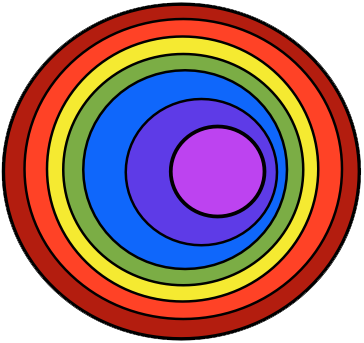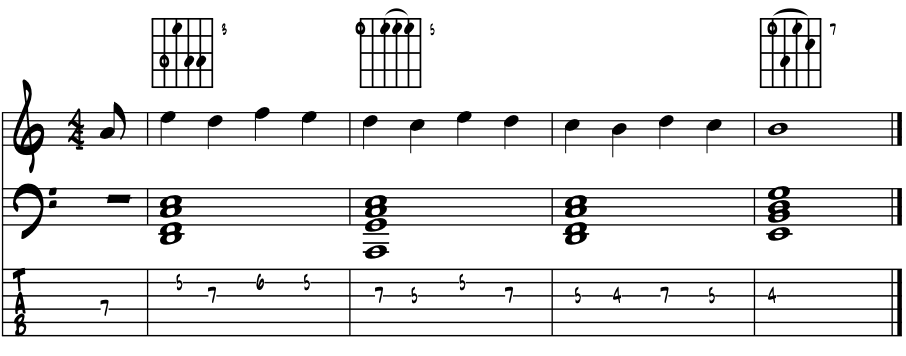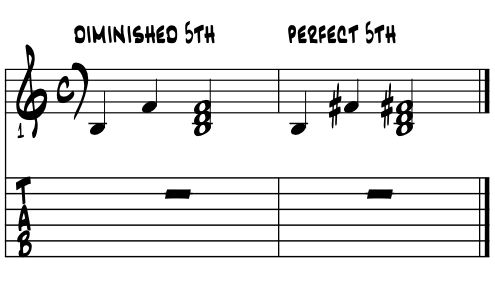~ 7 Ancient Diatonic Modes ~ ~ Dorian Phrygian Lydian Mixolydian ~ ~ Ionian Aeolian Locrian ~ ~ ancient colors and Glarean ~ ~ theory / history evolutions ~ ~ today's relative major minor ~ ~ letter name modal theory secrets ~ ~ the now ancient 'hypo' weave ~ ~ modal composition and improvisation ~ ~ guitar: seven modes over five shapes ~ ~ coda: modal colors in open 'G' tuning ~
|
In a nutshell. There's three essentials in the following discussion of our modern '7 pitch modes.' These are their letter name pitches, where the half steps locate within each loop and what the intervals then create in musical sounds; both with melody and harmony thanks to modern tunings. Master these theory basics with the 'A B C D E F G A' letter name loop and we're back on the golden road to unlimited devotion. Understanding the 'theory' of the modes is easy, bringing modal flavor, some of which is now ancient, into our art is the challenge. Hint: just find those half step locations :) |
The 'modes' of Americana musics are the unique groups of pitches that each have their own special character to portray the emotional story of our music and songs. Joyous song ? Use the pitches of joyous mode to make its melody, so probably leaning major; Ionian, Lydian, Mixolydian. Sad song ? So, a sad mode, so traditionally in a minor mode; so Dorian, Phrygian, Aeolian and Locrian lean towards sadder stories to be told. Historically thought to flow in descending melodies and patterns of the pitches, today we can also locate each unique mode within the larger framework we modernists call the diatonic realm and its seven pitches. And backed by chords, lines of any and all directions can bring a modal mood. The Dorian, Lydian, Mixolydian and Phrygian modes we have from the times of Pythagorean era Greek musics, while Ionian and Aeolian, while having Greek names, lean more to the original, natural pentatonic scale owned equally by all indigenous peoples around the world. Modern artists working with these aural colors will eventually bump into them all. |
|
Americana songs / diatonic 3 and 3 = six out of seven. Used throughout, this idea of a 'diatonic 3 and 3' theory clues us into the major / minor pairing and its balance within a diatonic key center. For with one group of seven pitches we achieve; three modes in major and three modes in minor three major triads and three minor triads 1 4 5 chords major ~ 1 4 5 chords minor pair major and minor ~ key center So a real even balancing of our two main song writing moods; major and minor tonalities. |
In songs. The basis of the modes as colors for composition hinges mightily on the presence of a perfect 5th interval within a grouping. And of the seven modes commonly available, six contain this interval. The mode built on Seven, the Locrian mode, does not. A perfect 5th above a root note is the 'dominant.' And with these two pitches; root and dominant, a key center is sparked to life based on proximity and the way we hear and feel these pitches. Thinking in 'C', modes with roots and perfect 5th's interval. C to G / Ionian D to A / Dorian E to B / Phrygian F to C / Lydian G to D / Mixolydian A to E / Aeolian B to F / Locrian / no perfect 5th So we've six out of seven, with a perfect fifth in the mode, giving us the two primary notes for creating that sense of key center, home and away, its tonal gravity and creating a sense of forward motion to a future point and even to greater predictability in the music; anticipation. The 'B to F', of the Locrian mode, while not a common key center, provides us energy of a diminished 5th, the tritone, whose energy we commonly use in all the other modes, the essence of V7, and half the basis of V7b9, out chord substitution portal. |
The modal guitar. Knowing that the modes hold the original pitches that are still creating our melodies of today, we could easily lean a bit deeper towards the musical realms of the legends through our histories; knowing that a melody made from the pitches of a mode today can carry all of its historical energies and meanings, carry its nuances and powers, that ties the artist into the universal energies to channel and share with their listeners. So in theory, if today's relative major 'G and E minor' pairing of pitches / letter names; which we as the Ionian (G major) and Aeolian (E minor) modes, have that 'built in' richness of sonority on any guitar, then it follows that melodies created in the 'A' Dorian mode, or 'B' Phrygian, 'C' Lydian, 'D' Mixolydian and 'F#' Locrian can have the extra 'built in' deeper sonority on a guitar too, we each just have to find it. |
Heinrich Glarean. Our current discussions here are thanks to H. Glarean, who according to Grout, codified the organization of the pitches of his day, circa 1547, into the modern modes / scales as we know them today. |
|
Nut within the shell. What we know and generally term today in theory as a 'mode' or even a 'church mode', mostly comes to us by way of the Western ancients, those succeeding generations of Mediterranean geographic dwellers who first began to figure out and knit together, to preserve and carry forward the philosophies, mathematics and arts, that shapes the basis of what we know today as our Western Civilization. |
|
Modal history speaking, in between all the way back to the Greeks and today, lived the Swiss music theorist Glareanus, who in the mid 1500's knit together the modal theory and organization of pitches into the melodic resources we still use today. Reconstructed here throughout the following discussions, what Glareanus seems to have first inherited and what he eventually passed along in writing for posterity sake are remarkably quite different given the pitches are mostly the same. |
|
For it was around this point in our now written down record that we have actual original copies of, that we first hear that our regular old, run of the mill relative major / minor scale of today is recognized as the most popular mode of the olden days also. Back then it was the Ionian mode. And why was that? Well, mostly in that with modes we create melodies. Within two centuries these modal pitches will be tempered in tuning, and through this process become known as the major scale, who's tuned up precision pitches are now also stackable into chords. So the best of both; melodies and chords, yet still with challenges. |
In these earlier times not much got written down as most folks were challenged in reading and writing letters let alone music notation. So folks rote learned their music generationally and those that could read and write, determined what got put in the history books. Luckily for us Glareanus could and did. |
So folks rote learned and memorized their music? Like most of us Americano musicians today? Yep. Must have been some improv involved too. Hard to imagine there wasn't. Today we know that this major scale group of pitches has been around the longest, known by generations of musical artists and creating an endless library of memorable and joyous melodies. |
And these memorable melodies backed the lyrics that told the stories that folks loved to hear, sing along with and dance around too ? Just like it is today? Yep, same as nowadays. Folks still love to listen, tap a foot, maybe sing and surely dance around right? Folks do still love to dance around ? They do here in Alaska. For with this diatonic, major scale ordering of the pitches, composers have wrote the majority of popular songs for regular folks to enjoy each day. |
|
This 'most popular' ordering of these pitches remains true to this day in our own Americana musics too. For the rather vast majority of our musics, both past and present, is written in the diatonic relative major / minor pairing. This is surely the case in creating the chords to back the melody lines. And aren't the pitches of the key center of 'C' major and 'A' minor the ones built right into the white keys of our pianos? Yep, they sure are. Example 1. |
|
|
Look familiar? Cool. No? Then do consider learning and memorizing this sequence of the pitches, that forms the basis of so much music theory, all built right into the piano keys. Or any of our keyboards for that matter; electric pianos, synths, organs, the melodica etc., for this exact sequencing of the pitches has surely been with us for a very very long time now. |
Evolutions. The historical evolution of the seven core modes of today comes to us as the combined package of two historical periods. The earlier, from the ancient Greeks, brings us four modes; Dorian, Phrygian Lydian and Mixolydian. The more recent addition of two modes by Swiss theorist Glareanus gives us the Ionian and Aeolian modes. These we commonly know of today as the diatonic relative major and minor scales. So that makes a total of six modes. Three major three minor? Yep ... and the basis of the 'diatonic 3 and 3?' |
The seventh mode is possibly still a bit of a mystery in its historical origins. Regardless, commonly known today as the Locrian mode, its diminished 5th interval has long inhibited its abilities in composition as a modal key center. Diminished 5th as in tritone 'catalyst?' The V7 chord and blues music essential? Exactly, the 'diablo' de musica! Seven is also the leading tone. |
Modal melodies hint of 'ethnic' flavored melodies. For these modes were the 'earlier' theory system used in creating the horizontal, more linear shaped music of earlier European cultures, up to the early 1600's or so. Is this the style of composition before we moved into a more vertical approach that comes with harmony and chords? Yep. We often call it 'plainsong.' |
|
Our musics went from one melody line, to many melody lines together which when rhythmically lined up sounded like chords. Once harmony was established, we then went back to one melody line, but now supported by vertical stacks of pitches or chords. By the time we got back to one melody line, the pitches that had been our modes had evolved through a refinement of tuning to become today's modern scales. Cool? |
|
'Rhythmic mode.' A 'rhythmic mode' is a set beat pattern of notes that form a loop, a rhythm phrase repeated, that supports the lyrics of the song. For in classical poetry during the 'modal era', circa the 1100's or so, there were structural forms for poets for presenting their words and they 'rhythm modes' to motorize their lines. In a comparison to today's Americana musics, we've a 12 bar blues form for the lyrics / poetry / words of a song motored by a 12/8 shuffle beat to motor things along. In the blues, there's quite a few 'rhythmic modes.' Explore. |
What's in a name? Is our modern 'scale' different than an ancient 'mode?' Yes it is. For while they do share identical theories of pitches and intervals, they do not share of the same system of tuning thus have fairly distinct abilities. In theory, a 'scale' is associated with the modern idea as being within an equal temper tuned diatonic key center for composition. As such, it is capable of the full range of harmony and modulation. |
An ancient 'mode' is a stand alone group or ordering of pitches that creates its own complete compositional resource with just its seven pitches, no functional harmony or range of modulation is available. |
|
The basic letter pitch theory. In today's terms, basic modal theory follows perfectly with our other main resources when filtered through the diatonic scheme of scales, arpeggios and chords. The basic breakdown follows the same pathway mantra; that in a lot of our Americana music we're either finding our way to Four, or from Four, finding our way back to One. |
That we get all three of the One / Four and Five triads of both the major and minor tonalities within the same diatonic scale is built right in. The modes as outlined by Glareanus and equal temper tuned, slip into this scheme perfectly. Please examine a chart of this very essential theory; 'C' Ionian / 'A' Aeolian pitches. Example 2. |
scale degrees |
1 |
2 |
3 |
4 |
5 |
6 |
7 |
8 |
|
C major |
C |
D |
E |
F |
G |
A |
B |
C |
Ionian |
arpeggio |
C |
E |
G |
B |
D |
F |
A |
C |
|
One / C major |
C |
E |
G |
. |
. |
. |
. |
. |
Ionian |
Four / F major |
. |
. |
. |
. |
. |
F |
A |
C |
Lydian |
Five / G major |
. |
. |
G |
B |
D |
. |
. |
. |
Mixolydian |
. |
. |
. |
. |
. |
. |
. |
. |
. |
. |
A minor |
A |
B |
C |
D |
E |
F |
G |
A |
Aeolian |
arpeggio |
A |
C |
E |
G |
B |
D |
F |
A |
|
One / A minor |
A |
C |
E |
. |
. |
. |
. |
. |
Aeolian |
Four / D minor |
. |
. |
. |
. |
. |
D |
F |
A |
Dorian |
Five / E minor |
. |
. |
E |
G |
B |
. |
. |
. |
Phrygian |
. |
. |
. |
. |
. |
. |
. |
. |
. |
. |
Seven / Two |
. |
. |
. |
. |
B |
D |
F |
. |
Locrian |
Cool and consistent. From the major scale we get the One / Four and Five triads and their corresponding major modes; Ionian, Lydian and Mixolydian. Same for minor; three minor triads and corresponding minor modes; Aeolian, Dorian and Phrygian. Seven / Locrian, also minor, becomes the pivot triad / chord between them. |
Groups within a group. In today's terms and surely here in Essentials, the quick take on understanding modal theory is based on creating seven unique groups of pitches from the basis of the diatonic major relative minor group of pitches. In doing so we learn the same rules as with the major scales that allow us to project the exact same theory from each of our 12 pitches and create the 12 major / minor paired key centers. |
So along these lines we initially can think of the modes as just different start and end points of the looping nature of the diatonic major / relative minor scale. In this next idea we use the pitches of the tonal center of 'C' major to spell out our seven modes of today's modern palette. Seriously consider rote learning this chart. Example 4. |
numerical scale degrees |
1 |
2 |
3 |
4 |
5 |
6 |
7 |
8 |
C major scale / Ionian |
C |
D |
E |
F |
G |
A |
B |
C |
D Dorian |
D |
E |
F |
G |
A |
B |
C |
D |
E Phrygian |
E |
F |
G |
A |
B |
C |
D |
E |
F Lydian |
F |
G |
A |
B |
C |
D |
E |
F |
G Mixolydian |
G |
A |
B |
C |
D |
E |
F |
G |
A natural minor / Aeolian |
A |
B |
C |
D |
E |
F |
G |
A |
B Locrian |
B |
C |
D |
E |
F |
G |
A |
B |
Seven loops within a group. That the pitches of the 'C' major scale from 'B' to 'B' in theory and practice today make the Locrian mode, is the initial way of thinking to get a sense of the deal here. 'D' to 'D' is Dorian, F Lydian is 'F' to 'F' and so forth. These seven form the core. That we can project this same theory equally from each of the 12 pitches of our equal temper tuned chromatic scale is the music and pitch theories built right into the piano. |
The piano embodies this 'anything from anywhere'; any scale, mode, arpeggio, chord, lick, riff, line or ditty from any of the 12 pitches all in tune with themselves and in relation to one another. Mighty big resource. And are there other modes created in a similar manner from our other melodic resources? Yep, exact same process with any group of pitches really. |
For the guitar, we build this modal theory of looping pitches within loops into the learning method, becoming the pathway to developing the 'anything from anywhere' chops a jazz leaning guitar player might aspire to acquire. |
For there's a true relationship between modes and styles, between modes and the songs of distinct nationalities, often a forever or historical relationship joining a mode championed in the music created by a unique group of people. Along these lines, if you're in a Klezmer band, you'll probably know the various modes of the harmonic minor grouping of pitches better than most. Backing up Flamenco dancers? The Phrygian mode in 'E' is most likely the core group. |
|
When we hear a melody with certain twists, we almost intuitively know its cultural origins. Whether we should thank Hollywood for these musical images or not, its basis in modal history should not be denied. For it opens us up to a whole world of musics already potentially right under our fingertips :) And once we know it's there, we can search. So within each of the seven groups, what theory component helps determines its unique sound? |
|
Location of the half steps. Does the location of the half steps within each mode have the greatest effect on its overall color and emotional quality? That could very well be the case, as the half steps help determine the main attributes; what quality of third for major or minor. What quality of perfect fifth interval, the historically dominant interval of our AmerEuro music. And the seventh; a major 7th leading tone or blue minor 7th? Which when paired with the third determines chord type, a theory way to categorize chords by the sense of direction they create and our artistic sense of 'arrival', depending on the setting and style of music we're in. |
Artistically of course, it might all just boil down to what we each hear, how these sounds resonate on our internal muse, and what inspiration it conjures in our work. The following chart is simply organized to see the gradually shifting half steps of our core diatonic major scale formula as we navigate through the whole steps and half steps of our seven distinct diatonic modes. Example 5. |
~ new patterns emerge ~ |
Ionian mode formula |
1 |
1 |
1 / 2 |
1 |
1 |
1 |
1 / 2 |
Dorian mode formula |
1 |
1 / 2 |
1 |
1 |
1 |
1 / 2 |
1 |
Phrygian mode formula |
1 / 2 |
1 |
1 |
1 |
1 / 2 |
1 |
1 |
Locrian mode formula |
1 |
1 |
1 |
1 / 2 |
1 |
1 |
1 / 2 |
Mixolydian mode formula |
1 |
1 |
1 / 2 |
1 |
1 |
1 / 2 |
1 |
Aeolian mode formula |
1 |
1 / 2 |
1 |
1 |
1 / 2 |
1 |
1 |
Locrian mode formula |
1 / 2 |
1 |
1 |
1 / 2 |
1 |
1 |
1 |
Ionian mode formula |
1 |
1 |
1 / 2 |
1 |
1 |
1 |
1 / 2 |
Pretty clear migration of the 1/2 step as we descend through the chart. That by simply changing the starting point of the same sequence of whole steps and half steps, our modal groups evolve. Principally based on the half step location, each grouping retains its own unique ancient sound and character potentials. |
The following discussions examine each group by using the just white keys on the piano to create melody lines that capture each color simply by emphasizing the natural half steps within each group created from within same exact loop of pitches. |
Ionian mode / major scale / diatonic scale. From the above discussions or these links we can choose to research and believe that this grouping has really been at the center of the local melodic universe for an awfully long long long time. Three longs? Yep, long time back to the caves of Central Europe. |
|
Here are the intervals and pitches with C as our root pitch. This C Ionian / major scale becomes what we term our parent scale for the ideas which follow. If necessary, please memorize this interval formula. Example 6. |
|
scale degrees |
1 |
2 |
3 |
4 |
5 |
6 |
7 |
8 |
Ionian mode / major scale formula |
1 |
1 |
1 / 2 |
1 |
1 |
1 |
1 / 2 |
|
letter name pitches |
C |
D |
E |
F |
G |
A |
B |
C |
Ionian character. Clearly we have the major third E above the root creating the major tonality. The half step ascending to Four creates the lovely uplifting motion of spirit we often associate with Americana gospel flavor, providing an identical secondary resting point as the tonic / One within a key center. The three successive whole steps of the second tetrachord boldly stepping upwards towards our upper tonic with a half step motion to cap its arrival, resolving any doubt of where we were going and how we got there. |
Of course the reverse of this description is also true, that a scaler descending major scale line is just as directional and confidently resolving. Here are both. Remember, do try and sing or hum along with the pitches in all of the examples. Sing and play is the Americana way. Follow along the notation for reading too. Example 6a. |
Easy to sing? Cool. These pitches can go pretty deep. |
A question. Are we as American musicians so steeped in the sounds of the major scale that even just scale-wise motion up and down resolves? Pretty much. The diatonic major scale descending line, with various rhythmic nuances, becomes the hook or riff often used in the folk, bluegrass and gospel styles. |
This major scale grouping and its relative natural minor, has proven itself worthy as the group of pitches for all the composer kings over the last 1000 years or so. At least since notation came around. But is it time to let the tritone within go? Even for just a hundred years or so? |
This next line created from the pitches of the Ionian mode / major scale has a bit of a nursery rhyme, children's song sort of feel, in 3. Example 6b. |
Right up the triad with some sequence in the second half. Lots and lots more of old time fun Ionian lines included to rote learn in a couple of keys, at least :) |
Dorian mode. This early grouping passed along from our theory Ancients is a very powerful representation of the minor tonality. We can find shades of Dorian somewhere in all of the American styles. The minor third above the root sets the overall tonality of the mode. The major 6th above the root is the giveaway for Dorian lines. , is a far stronger lean towards the major tonality than the minor 6th of natural minor grouping. As the one key distinction between the Dorian and natural minor groups, we rarely find them both in a melody, unless the motion is chromatic of course :) |
|
In improvisation, Dorian is of course a key player over the Two minor 7th chord as we find it on the second scale degree of our system. Dorian is a very common melodic substitution color with any unaltered V7 chord. In composition, the Dorian mode played a pivotal role in the evolution of American jazz during the later 1950's and forward, setting the stage for the final steps up to the 12 tone free jazz of the later 1960's. Please examine the pitches and D Dorian scale formula. Example 7. |
|
scale degrees |
1 |
2 |
3 |
4 |
5 |
6 |
7 |
8 |
Dorian mode formula |
1 |
1/2 |
1 |
1 |
1 |
1/2 |
1 |
|
letter pitches |
D |
E |
F |
G |
A |
B |
C |
D |
Dorian character. The minor third F above the root creates Dorian's overall minor tonality. That we don't diatonically get a minor Four chord in Dorian creates some interesting compositional possibilities. Perhaps this is the first real step in seeing how Two came to sub for Four in the major key. The sleeker D-7 chord handling the brighter tempos as the music evolved over the early decades of the last century. |
The Dorian mode also plays a core role in what could become a new futuristic tonal organization of our equal tempered pitches based on the #15 interval. For now just purely modal ancient. Example 7a. |
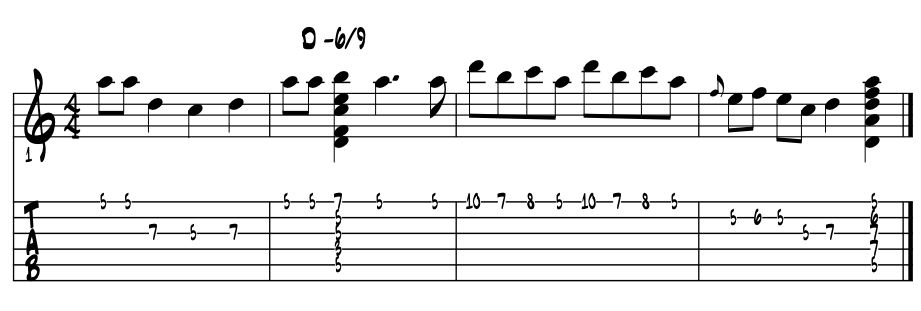 |
Descending Dorian sounds. Even without supporting changes, the powerful, minor character of the line emerges. This has a very rock / fusionesque character, or could with the right gear. A bluer start reaching up to A, then a quick leap to the B natural where the minor 6/9 chord is struck. A repeated descending eighth note pattern encapsulates the minor triad and sets up the motion to our solid minor triad resolution. |
Dorian songs. Into the wayback to find the elegant "Scarborough Fair", which went to # 1 in the 1500's Elizabethan England. For jazz players, John Coltrane's "Impressions" and Miles Davis' "So What" are two popular jazz songs creating the Dorian environment for jazz styled improvisations. |
Dorian and the 'butter' shape. Well, even though Dorian is everywhere on the neck, its handiness and proximities in the 'butter' scale shape is nothing short of legendary. Talk about built right in, bolts right up and gives us a rather scootable arpeggio too :) Example 7b. |
 |
Phrygian mode. One of the Greek originals, the Phrygian (pr. Frid-gean) mode just might carry the strongest ethnic or national character of the ancient world into our present day lives. The opening half step interval can be an absolute giveaway to the overall color and emotional character of the line which often follows. |
|
With a thanks to Hollywood, we Americans often associate the Phrygian mode with the sounds of the Spanish; migrating with guitars from Spain over to their new world in Mexico and then to destination points north. This color is very much the core of flamenco guitar (in E) and dancing, where thunderous flourishes accentuate delicate passages of the Phrygian mysteries. Please examine its pitches. Example 8. |
|
scale degrees |
1 |
2 |
3 |
4 |
5 |
6 |
7 |
8 |
Phrygian mode formula |
1/2 |
1 |
1 |
1 |
1 / 2 |
1 |
1 |
|
letter pitches |
E |
F |
G |
A |
B |
C |
D |
E |
|
Billy Butler / Golden Earrings |
Phrygian character. The initial half step between the first and second scale degree is most essential to capturing the quality of the color. We see the second half step between the dominant B and C. We guitarist love to create all manner of nuance on these half step groupings of pitches. While our diatonic One chord is of course minor, it is not uncommon to see its third raised to create our core open E chord. When used with the diatonic Two and Three major triads, we create the classic Phrygian lick and when fanned, the motion becomes a core flamenco motor for the dancers. Example 8a. |
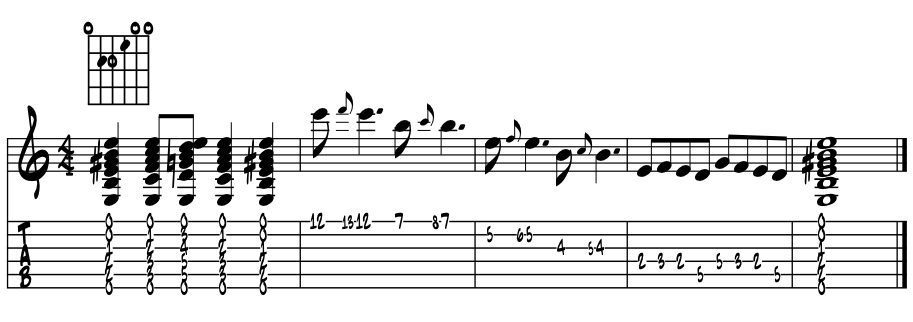 |
Descending Phrygian sounds. Classic becomes cliche here in my overly simple idea to get the color across. Using the open pedal E is cool and common with Phrygian. The idea of using the entire range of the instrument might be new but can create some very exciting lines. We theorists could 'legally' call the G# in the last bar a Picardy third. |
A borrowed pitch? We just borrowed a pitch right? To make the E major triad? That G# is not diatonic to Phrygian as built from the pitch E natural. 'Darn the diatonic and theory rules', sometimes ya just gotta do what ya just gotta to work the magic :) |
Phrygian melody. Drawing a blank here sorry. |
Lydian mode. One of the four original modes that we inherit from the ancient Greeks, the Lydian color has found a secure place on the modern American jazz compositional and improvisational palette. Basically a major scale with an augmented fourth, we get a bit of whole tone color out front with its three whole steps followed by a more traditional diatonic finish. Please examine the pitches. Example 9. |
scale degrees |
1 |
2 |
3 |
4 |
5 |
6 |
7 |
8 |
Lydian mode formula |
1 |
1 |
1 |
1 / 2 |
1 |
1 |
1 / 2 |
|
letter pitches |
F |
G |
A |
B |
C |
D |
E |
F |
Ascending Lydian character. The major third A above the root creates the major tonality and the initial three whole steps of this grouping provides that wisp of whole tone color. So very often we'll find this B natural up an octave as the #11th colortone of the arpeggio. The #11 eases including the major 3rd in the chord triad basis; (major 3rd 'A' and #11 'A#' in the same chord). Ex. 9a. |
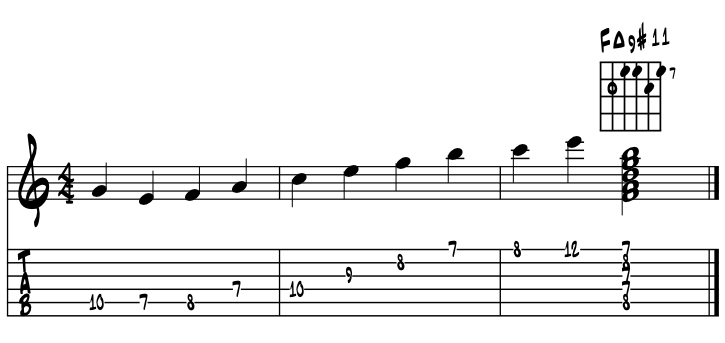 |
Lydian sounds. There is a poignancy of boldness in the Lydian color that can create a sense of confidence. The whole tone quality does suspend things a wee bit in terms of tonal direction, adding another component to our compositional tools to shape aural predictability and its musical tension and release. Those in the know probably caught the open D major triad shape in the chord voicing in this last idea. Stacking major triads atop one another potentially opens up the polytonal world. |
A one pitch shift to new coolness. A fairly common variation of this diatonic derived Lydian group is to lower its 7th by half step, to create a group often termed 'Lydian b7.' In this evolved grouping we lower the leading tone 7th by half step, creating a tritone interval between the major 3rd and minor 7th, moving us into dominant type colors and all of their possible machinations. So a dominant color with a bit of built in Lydian whole tone? Yep, pretty much. Examine the evolution of these pitches and their sound. Example 9b. |
scale degrees |
1 |
2 |
3 |
4 |
5 |
6 |
7 |
8 |
Lydian mode formula |
1 |
1 |
1 |
1 / 2 |
1 |
1 |
1 / 2 |
|
letter pitches |
F |
G |
A |
B |
C |
D |
E |
F |
Lydian b7 mode formula |
1 |
1 |
1 |
1 / 2 |
1 |
1 / 2 |
1 |
|
letter pitches |
F |
G |
A |
B |
C |
D |
Eb |
F |
Compare the sounds of these two groups. Example 9c. |
 |
Definitely a slight variations of flavor there yes with the Lydian b7 color. The ascending arpeggio in bar 2, with its handy fingering and shape, is a keeper for sure. In bar 4 some, the essential jazz guitar fingering philosophy applies. |
So in this Lydian 'b7' group we pick up a second tritone pair of pitches; 'F to B' and 'A to Eb.' Another tritone catalyst? Yep, another way to bring some blues hue, make some tension and portal to points beyond. |
Lydian b7 dominant mode. As we've created our modes from different starting points within one defined set or loop of pitches, turns out that we've the common melodic minor scale starting from Five of Lydian b7. Please examine the pitches. Example 9d. |
Lydian b7 mode letter pitches |
F |
G |
A |
B |
C |
D |
Eb |
F |
melodic minor from Five |
C |
D |
Eb |
F |
G |
A |
B |
C |
 |
Cool huh? is there more to this melodic minor group in jazz substitution and improv / soloing? Might be :) |
wiki ~ anonymous |
Mixolydian mode. Historically the last of our original groupings of pitches from the ancient Greeks, we can find the Mixolydian melodic color within any of the music and styles that we can trace back to the ancient Celts of Britain. The old-timey Appalachian folk song "Old Joe Clarke" is an early American classic based on the Mixolydian group of pitches. Improvising musicians often associate Mixolydian sounds with dominant harmony, as both hold the major 3rd / flat 7th tritone and are built from the 5th degree of the diatonic major scale. Please examine the pitches and location of the Mixolydian mode's half steps. Example 10. |
|
scale degrees |
1 |
2 |
3 |
4 |
5 |
6 |
7 |
8 |
Mixolydian mode formula |
1 |
1 |
1 / 2 |
1 |
1 |
1 / 2 |
1 |
|
letter pitches |
G |
A |
B |
C |
D |
E |
F |
G |
Gradually descending Mixolydian character. The major third B above the root of course creates the major tonality. Interesting perhaps is that as the pitches descend from Four towards the root, we get a similar motion and sense of resolution as that of the Ionian / major scale group. Ascending melodic motion bumps into the dominant, flat or blue 7th, that changes the dynamic of this resolution. Thus the essential of the Mixolydian spice. Here's a nip of the 'Old Joe' in eight notes. Example 10a. |
|
 |
Mixolydian sounds. That blue 7th high point in the line surely creates a lovely sense of the rub. The line seems to charge up to the F, then repeats. There are words for this melody of course which all combined tells the character in the story. These modal pitches, with additional blue notes peppered in, becomes a core color for jazz players. For in the blues, so often the tonic chord is a dominant chord type, and the major 3rd above the root figures in a lot. |
Many essential blues melodies follow the alternating tonic major 3rd / minor 3rd switch as our chords move from One to Four. Slice in the blue 3rd, and fill the whole between between the 4th and 5th scale degrees with a blue tritone and we got solid group of pitches to create our jazz / blues style melodies. Example 10b. |
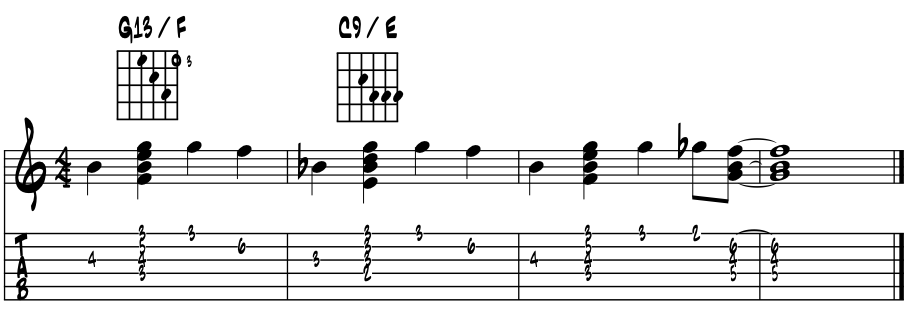 |
Mixolydian flat Seven cadential motions. This next idea might be the most important one in this whole for some readers. Turns out that if we build a dominant chord on 'b7', we get an earthy cadential motion back to One. Having some variety for V7 is cool and while we do have a ton of it with 'b9' substitutions and forward, this 'b7 to One cadential motion is a modal coloring of the harmony, maybe leaning more to a pop rock essence and of course 'flat Seven' can always bring some blues. Here in 'C' major. Example 10cc. |
|
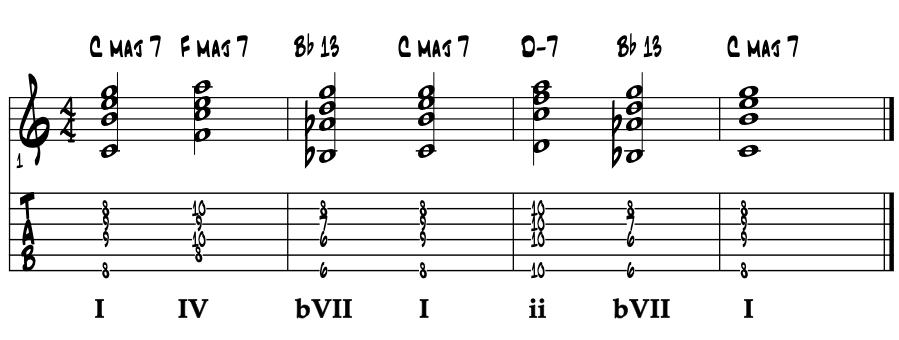 |
Sound a bit modal but with a strong sense of resolution? Cool. Work in minor? You bet. No surprise that there's a ton of this all through the 'Lads from Liverpool' library. Hard bop monsters too a la Art Blakey And The Jazz Messengers. There's a few other fairly common chord shapes to find this 'b7' resolution for starting out with using modal colors with the harmony, here adding in motion to a minor tonic. Example 10d. |
|
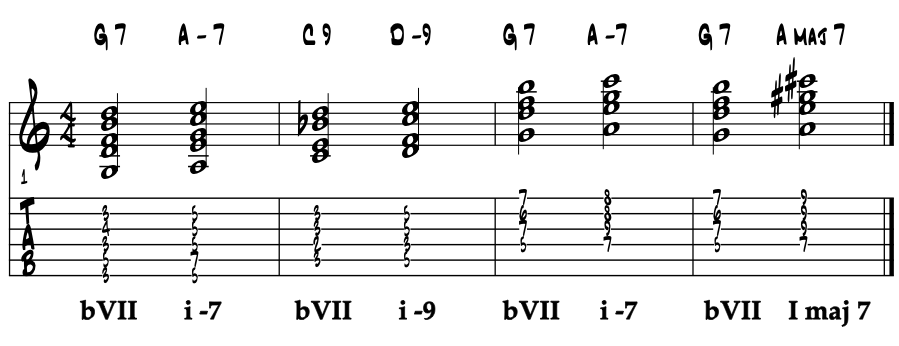 |
Finding shapes while moving upward and across the strings, cats might also call these motions into the minor tonic a bit of a 'deceptive' cadence depending on the grand scheme of the song employed. The second motion is a fairly common idea for bossa nova stylings, especially in vamp sections, b7 to 1 major and minor is lovely and of course 'bossa loves the 9', well ... we all do depending. Last motion we employ the ever ancient 'picardy 3rd', that historically mysterious shifting of colors towards the light. |
|
Aeolian mode / natural minor / relative minor. This ancient grouping of pitches is really at the center of the local American melodic universe. Folk, blues, rock and jazzer's all need this color's pitches to work the magic. For even though nowadays the major scale reigns, I bet if we to take the wayback machine all the way back, that along with its Ionian partner, this group would be ancient king of melody makers. |
As modern theorists we usually just call it the natural minor scale. Paired with the Ionian / major scale, this combined grouping of pitches has created the bulk of our melodies. Please examine the intervals and pitches of the Aeolian / natural minor group projected from our root pitch A. Example 11. |
scale degrees |
1 |
2 |
3 |
4 |
5 |
6 |
7 |
8 |
Aeolian mode formula |
1 |
1 / 2 |
1 |
1 |
1 / 2 |
1 |
1 |
|
letter pitches |
A |
B |
C |
D |
E |
F |
G |
A |
Aeolian character. Of course the minor 3rd interval from the root (A to C) creates the overall minor tonality. The minor or blue 7th at the close (G to A) evoking its character so evident in the blues and rock influences in the American sounds. The unique, artistic poignancy of the minor 6th interval (A to F), is crucial to the mode. We also need this F natural to create our minor Four chord, a key motion in all of the American styles, in both our major and minor key schemes. This next idea is the B section of an Alaska themed original composition of mine, "Voices From The River." Example 11a. |
Aeolian sounds. Clearly an earthy sort of minor color, Aeolian mode can be somewhat somber yet loving, with a reverence and compassion unmatched by any other grouping. The 'F' natural in the first bar really sets the tone of the line. As this is the second melody of the tune, the penultimate note B at the close sets up the repeat of the line. As time permits, rote up George Gershwin's classic line in "Summertime", for its deep Aeolian character and well crafted qualities. For in this one song, a lot of what we do in our Americana musics, for songs written in a minor keys and colors, comes together in a true story. |
|
Locrian mode. Our final core mode is built upon the seventh scale degree and has the singular distinction of not having the stabilizing influence of having an interval of a perfect 5th above its root. Out of all seven groups just this one? Yep. Locrian diatonically creates the half diminished colors, an essential pivot chord or portal between the major minor Yin Yang of it all. Locrian is also the parent scale for improvisation over these half diminished harmonies. Please examine two common half diminished voicings linking the diatonic major and relative minor. Example 12. |
|
Locrian also doesn't really have a definitive historical start point. It somehow got wiggled in during the 1700's, completing the modern modal theory of seven we've enjoyed since. As mentioned just above, the fifth of Locrian is diminished. So a diminished fifth in its triad ? Yep. This one property alone can minimize this group's role as a primary or secondary key center in composing. Examine the two fifth's from the root pitch B. Ex. 12a. |
Isn't that diminished fifth a tritone? Sure is. So a diminished triad? Yep. And we diatonically just don't have an F# in C major do we? Or C minor for that matter? Nope. So how did we create a B minor triad from the pitches of C major / A minor? In pure theory? We have to borrow it from another key. Please examine the Locrian pitches and formula as created from B, the leading tone, seventh degree of the C major group. Example 12b. |
scale degrees |
1 |
2 |
3 |
4 |
5 |
6 |
7 |
8 |
Locrian mode formula |
1 / 2 |
1 |
1 |
1 / 2 |
1 |
1 |
1 |
|
letter pitches |
B |
C |
D |
E |
F |
G |
A |
B |
Locrian character. The initial half step and minor 3rd clearly define the minor tonality. The root B to F natural creates the said dissonant tritone / diminished 5th interval, thought to detract from the overall stability of this group. Thus, perhaps the Locrian scale or chord are not as clearly major or minor as compared to our other six groupings. Is it this unique quality of somewhat tonal ambiguity that gives Locrian its character ability to smoothly morph our compositions between our major and minor tonal environments? Could be. |
Richard Wagner's "Tristan" chord has fascinated theorists for centuries. From a jazz perspective of today the 'Tristan' chord can be viewed simply as a half diminished seventh chord. In its own day it was a revolutionary color to be used as the lead character's 'theme.' Jazz players love this color, commonly termed 'half diminished seventh' or numerically represented as the minor seven flat five (-7b5) chord, as it provides a diatonic choice of a rather complex color that is not quite fully diminished. A Locrian line. Example 12c. |
|
 |
Locrian sounds. The above idea focuses in on the pitches and intervals that help make Locrian unique. Thus the motion to the F natural on beat three of measure two. The whole step cadential motion at the close of the line helps to bring out Locrian's more bluesier, Mixolydian character for which this group is so often associated with in the more theoretically developed American styles. |
Looking deeper into these church modes. Just as we've done in the above examples, where we took one group of pitches and examined each grouping within by making each pitch in turn our tonic pitch, we can also look into each of these modes and follow similar pathways. And while this might sound redundant, there are some cool things that shake loose to consider. |
Our written history tells us that in the beginning days of our music theory, the original Greek modes of Dorian, Phrygian, Lydian and Mixolydian were the four melodic resource for composers. Formed into melodies within an octave span, when their work needed a contrasting section, they created a 'mode within a mode' grouping to achieve a diversity of color (sound familiar ...). |
Early evolution of the resource. These new modes are termed a plagal or hypo mode, and spans the octave from a fourth below our tonic to the fifth above. This secondary group created a different set of intervals from which to create contrasting themes, encouraging musical composition to grow and thus evolve our musical forms. This simple process doubled our ancient resource from four to eight. Example 13. |
 |
Easy enough yes? And isn't Five the dominant in today's lingo? Yep it sure is. So even with the later addition of the three 'modern' modes of Aeolian, Ionian and Locrian to the core four, and the even later advent of equal temper tuning, that the same technique to create new 'groups from an existing group' is still a core spoke of the theory / composition wheel. Furthermore, that we can project each and any of these musical configurations equally from each of the 12 pitches of the chromatic scale becomes the whole theory tamale n'est-ce pas? |
Bring forth the ancient melodies. Might we modernists, when we compose modern modal pieces, be going back to when the hands of time pointed to a world lit only by fire? And can we recreate with this modal magic the vibe of those now ancient days? Surely we can try, for the ancient memories just might still be within each of us. I think this is why 'once a musician, always a musician' rings true for so many of us. For we are searchers on an endless quest of artistic and intellectual coolness of an artform that surely has a past, present and future to explore :) |
Our musical past is re-conjurable, the present is of course a gift, and the future what we try to make right with our music. As if any of us need a reason to be musicians, sorry. So regardless of the outcome of these unanswerable hypothetical questions and philosophical musings, we'll see the above process of finding 'modes within a mode', a re-arranging of the pieces of our musical and artistic puzzles, at least a few more times here and elsewhere before we complete our studies. Now back to the theory. |
Modal composition and improv. As the modes are of an older system of organization, the music we associate with their early basis is monophonic; one melody line sung in unison (1500's Europe). As voices were added that sung a different melody along with the original, polyphonic music evolved; two or more melodies woven together (1600's). As the pitches of these melodies started to line up rhythmically and be sounded together, the evolution of the idea of harmony and chords began. And as the pitches gradually became more uniformly tuned, we turned back to one melody line now supported by chords (1700's and forward). When we hear our Native American musics, chanting with drums and often flutes, this is a representative style of the modal music and composition that we also inherit from our Euro brethren and their evolutions. |
|
Modal composition today is often about capturing the overall character of the chosen mode which becomes the emotional center of the music. And that is where the music traditionally stays; within the chosen mode. For example, if a piece is written in Dorian mode, it will stay in Dorian. And while modulation is not uncommon, the Dorian flavor is retained, just centered on a new pitch. Or not as the composer intends. Why not pair two modes and evolve a way to morph from one into the other? |
So how is this different from our relative diatonic / Ionian / Aeolian pairing? It's not. Using our relative major / minor pairing is simply composing in the Ionian mode. A piece in a minor key, is simply composing in Aeolian mode. The texture of the music; one melody sung in unison, polyphonic or homophonic, are compositional factors to be considered. |
Carefully, well crafted modal art finds a melody line from the modal color that becomes the theme of the piece. This we state and variate in our improvisations. We compose a modal piece, or any music really, to get us into that particular emotional environment that comes to life with the sounding of the pitches of each of our modes That we can and often do historically locate each mode with an ethnic culture is just an additional part of the magic. So when we compose a modal piece, we often try to capture something of that ethnic character and the lives that those people lead in the lands they live. From that point forward most of the same compositional techniques we use with the Ionian / Aeolian pairing apply to modal composition. Intervals are explored and today can harmonize a modal melody just like any other. |
In the 1950's jazz artists looked to these modes for new inspiration and space to explore. In composition and improvisations, a 'modal' composition's emotional depth is aurally unmistakable really, when auditioned side by side with a diatonic composition of either a major or minor key. I wonder if the 'best selling' jazz record, the modal based "Kind Of Blue", also translates into most 'easily understood', in good part due to this music's ancient modal pitch basis, brought forth through the artistry of modern jazz artists ? So while in our work here we fully explore the diatonic realm of things, those in the know know of the modal contribution and the power of songs it brings to raise up spirits and set folks a dancing :) Like "Old Joe Clark?" Yep, and a hundred more Mixolydian fiddle tunes in that book. |
|
A modal blues. A modal blues is just a four bar vamp on a One chord. Any key of course, just a blues chord to anchor the deal and a series of four bar phrases. Example 14. |
 |
Really not much of a chart / road map. Lots of wide open spaces to fill in where needed :) Author's note; I've only heard this modal blues one time by piano wizard extraordinaire Marcus Roberts III. While really just a four bar phrase repeated, there's a sort of 'grind' to it that brings the 'true' blues. Check it out. |
|
The 7 modes through the 5 shapes. This last entry here begins to connect up the five scale shapes with the seven modes. That within each of the five shapes all the modes exist, some to a greater degree than others. By simply playing the shapes, from the different root notes, the seven modes emerge. Very cool. In this next idea, we simply locate the seven root notes of each of the modes from within the pitches of scale shape # 1. Thinking in 'G' major, finding the seven modes within. Example 15. |
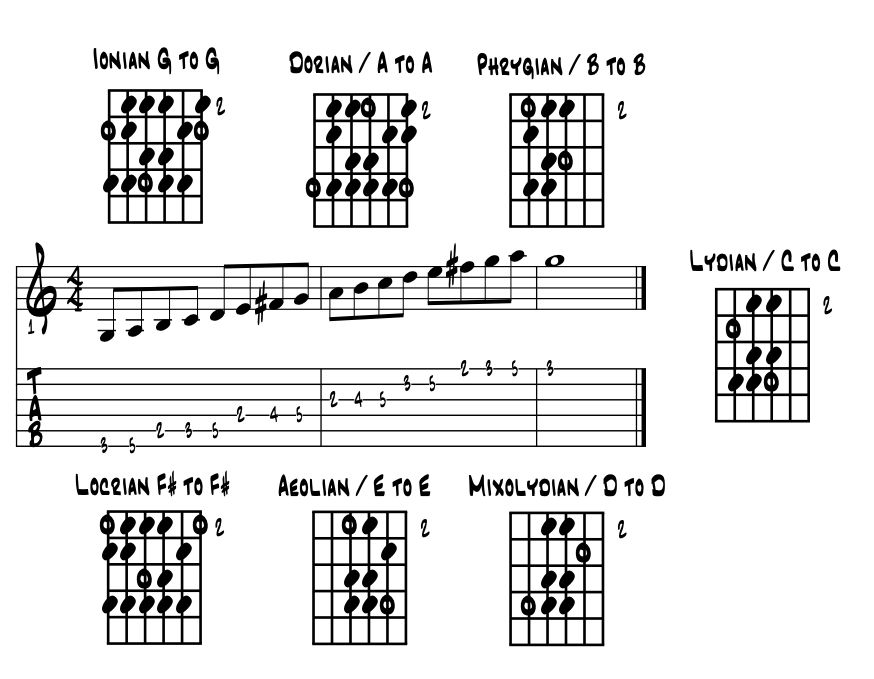 |
Cool? There's a bit of shedding here for those so impassioned. That said, tis an amazing thing how quickly the thought process evolves when we understand the theory of 'loops within loops' and look to the location of the half steps to extract each of the unique modal colors. In soloing 'over' the changes, as the chords weave through various progressions of the diatonic ' 3 and 3', all of this melds together in a very natural way; for those that hear the lines they want to play and know where those buttons are to push on their gitfiddles. |
Bass modes, modal bass lines, bass line stories and the modes. This is tricky all 'round. While these next few idea are as cliche as possible, aiming to better get the flavor of each of the seven modes, and thinking bass line story, so a basic line that could be worked into a modal song, for each of the seven groups. All in one swoop, the quickness in the playback line is to 'blur' one mode color into the next, each blur one of the seven. Starting with Ionian in 'G', and right on through the diatonic. Example 16. |
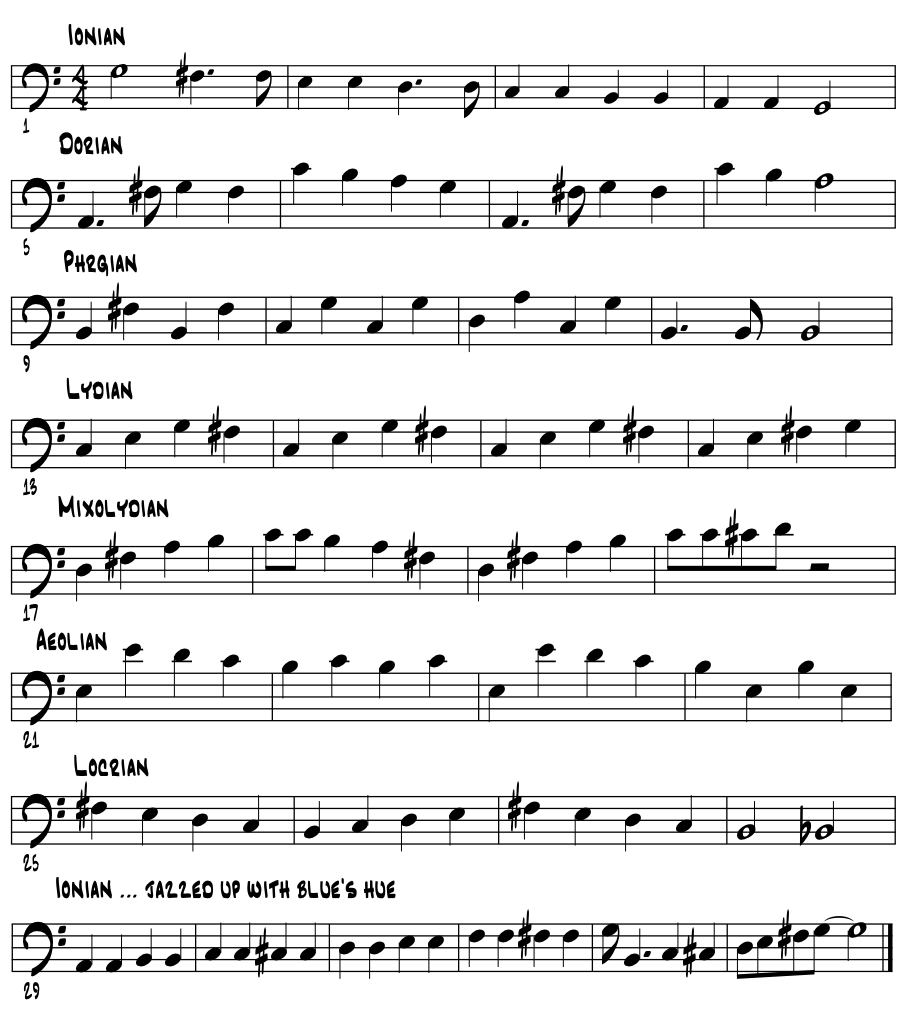 |
How cool is that? Hear the changing emotional character in the lines ? Cool. The basis of our bass line stories ? Maybe, surely the modes have been a historical part of our musical storytelling all along :) |
Review. These seven modes go way back in our history, four go all the way back, and as such, we each potentially have countless melodies in our memories to be rediscovered and explored through grouping up the pitches these seven ways. Throw in the 'hypo' versions and we've another set of seven to explore. There's just a ton here really for those so inclined. With the discovery of the math of equal temper tuning and its application to tuning the pitches, we modal players now get chord changes to back our lines. The best of both? Yep, best of both. And the compromises in tuning to 'equal' temper the pitches? Well, we all gets to give a little to create community and in doing so can gain a whole lot more. And as string players we bend yes? Bending alters pitch and pitch is tuning, so all is good in the hood, we just got to hear the pitch and find it then sing the line, play the line :) So the theory is simple n'est ce- pas ? An unbreakable loop of elements (pitches) with seven definite starting points. Each of the seven modes defined in part by the location of the two half steps intervals within. For where the half steps hang in the sequencing of the pitches helps to determine and clarify the overall emotional environment that each mode creates. Beyond that; explore and experiment, write some modal pieces and continue the search for the ancient lines that still might yet bring folks together in enjoying music, something we can all equally enjoy together. And listen to today's artists that pursue these now ancient modal colors. Multi-instrumentalist Loreena McKennitt has recreated the 'modal music world' with today's modern wizardry of all things cool. Beyond amazing music into the realm of transportative :) |
"Once you replace negative thoughts with positive ones, you'll start having positive results." |
wiki ~ Willie Nelson
|
References. References for this page's information comes from school, books and the bandstand and made way easier by the folks along the way. |
Find a mentor / e-book / academia Alaska. Always good to have a mentor when learning about things new to us. And with music and its magics, nice to have a friend or two ask questions and collaborate with. Seek and ye shall find. Local high schools, libraries, friends and family, musicians in your home town ... just ask around, someone will know someone who knows someone about music and can help you with your studies in the musical arts. |
|
Always keep in mind that all along life's journey there will be folks to help us and also folks we can help ... for we are not in this endeavor alone :) The now ancient natural truth is that we each are responsible for our own education. Positive answer this always 'to live by' question; 'who is responsible for your education ... ? |
Intensive tutoring. Luckily for musical artists like us, the learning dip of the 'covid years' can vanish quickly with intensive tutoring. For all disciplines; including all the sciences and the 'hands on' trade schools, that with tutoring, learning blossoms to 'catch us up.' In music ? The 'theory' of making musical art is built with just the 12 unique pitches, so easy to master with mentorship. And in 'practice ?' Luckily old school, the foundation that 'all responsibility for self betterment is ours alone.' Which in music, and same for all the arts, means to do what we really love to do ... to make music :) |
 |
"These books, and your capacity to understand them, are just the same in all places. Always bear in mind that your own resolution to succeed, is more important than any other one thing." |
|
Academia references of Alaska. And when you need university level answers to your questions and musings, and especially if you are considering a career in music and looking to continue your formal studies, begin to e-reach out to the Alaska University Music Campus communities and begin a dialogue with some of Alaska's finest resident maestros ! |
|
